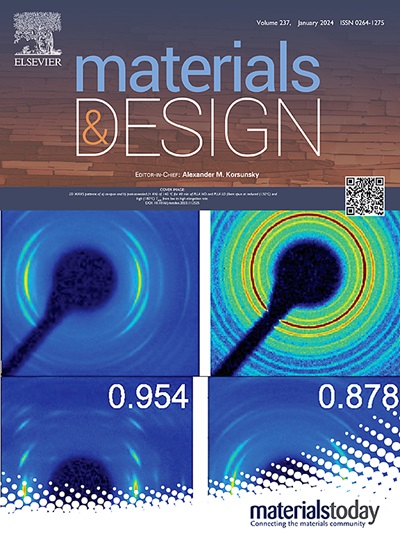Understanding the effect of tailored heat treatment on Zr-modified Al7075 fabricated by laser powder bed fusion
IF 7.9
2区 材料科学
Q1 MATERIALS SCIENCE, MULTIDISCIPLINARY
引用次数: 0
Abstract
Despite high-strength aluminium alloys now being widely processed by laser powder bed fusion (L-PBF), a specifically designed heat treatment (HT) for L-PBF Al7075 has yet to be identified and the microstructural features responsible for strengthening remain to be fully understood. In this study, fully dense Al7075+1.8%Zr was processed without hot cracking. High temperature heat treatments between 350°C and 525°C were adopted, attaining the highest hardness (162HV) at 425°C followed by an artificial ageing (AA). This heat treatment produced a yield strength of 515 MPa and an elongation at fracture of 12%. To understand the effect of this tailored low-temperature HT, comparisons were made with a classical T6 HT (1 h at 470°C followed by AA). Transmission electron microscopy analyses revealed a higher volume fraction of secondary precipitates with the 425°C HT than with the 470°C HT. These hardening precipitates were quantified as the main contributor to strengthening, accounting for 207 MPa. The 425°C HT prevented the over-ageing Zr precipitates generated by the 470°C HT, while inhibiting recrystallization. precipitates played a minor role in the tensile properties as they were nearly absent from the microstructure due to the excessive evaporation of Mg and Zn during L-PBF.

了解定制热处理对激光粉末床熔合制备zr改性Al7075的影响
尽管高强度铝合金现在广泛采用激光粉末床熔合(L-PBF)加工,但为L-PBF Al7075专门设计的热处理(HT)尚未确定,负责强化的显微组织特征仍有待充分了解。在本研究中,对全致密Al7075+1.8%Zr进行了无热裂处理。采用350 ~ 525℃的高温热处理,425℃时达到最高硬度(162HV),然后进行人工时效(AA)。该热处理产生了515 MPa的屈服强度和12%的断裂伸长率。为了了解这种量身定制的低温高温的效果,与经典的T6高温(在470°C下加热1小时,然后进行AA)进行了比较。透射电镜分析表明,425℃高温下Al3Zr L12次生相的体积分数高于470℃高温。这些硬化相是强化的主要因素,占207 MPa。425℃高温抑制了470℃高温产生的过时效Zr析出,同时抑制了再结晶。在L-PBF过程中,由于Mg和Zn的过度蒸发,η′析出物在微观组织中几乎不存在,对拉伸性能的影响较小。
本文章由计算机程序翻译,如有差异,请以英文原文为准。
求助全文
约1分钟内获得全文
求助全文
来源期刊

Materials & Design
Engineering-Mechanical Engineering
CiteScore
14.30
自引率
7.10%
发文量
1028
审稿时长
85 days
期刊介绍:
Materials and Design is a multi-disciplinary journal that publishes original research reports, review articles, and express communications. The journal focuses on studying the structure and properties of inorganic and organic materials, advancements in synthesis, processing, characterization, and testing, the design of materials and engineering systems, and their applications in technology. It aims to bring together various aspects of materials science, engineering, physics, and chemistry.
The journal explores themes ranging from materials to design and aims to reveal the connections between natural and artificial materials, as well as experiment and modeling. Manuscripts submitted to Materials and Design should contain elements of discovery and surprise, as they often contribute new insights into the architecture and function of matter.
 求助内容:
求助内容: 应助结果提醒方式:
应助结果提醒方式:


